Spatial and Temporal Variation of Dissolved Trace Metals from Mexican Caribbean Coast
Oceanography & Fisheries Open Access Journal Juniper publishers
Abstract
The concentrations of dissolved trace metals (Fe, Mn, Cr, Cu, Co, Ni, Pb, Zn, Cd, Sr, V, As) were analyzed in 56 water samples from the intertidal zone of the Mexican Caribbean coast during 2019 and 2020. The higher concentrations of dissolved metals (especially Pb, Ni, Cd) in 2019, suggest the influence of anthropogenic inputs mainly related to an intense development of tourism in the region. In 2020, higher variability was observed in the distribution pattern of metals related to the reduction in tourism activity due to the COVID 19 pandemic and the simultaneous enrichment effect from the runoff during the rainy episodes. The generation of anoxic regions in some beaches due to the great accumulation of Sargassum influences the mechanisms of mobilization/enrichment of dissolved metals (especially Ni, Cd). The concentrations of metals showed an increase of two (Ni) to ten times (Pb and As) in the coastal region, which suggests the urgent need for continuous monitoring that supports an adequate management program of the Mexican Caribbean coast.
Keywords: Dissolved trace metals; Tourist beaches; Quintana Roo; Caribbean Sea
Introduction
Beaches are especially tourist dominated regions which is highly dynamic in nature and have different complex system where it often interacts with both land and coastal region. The dynamic beaches often play a major role and act as a bridge between terrestrial and the open marine systems [1,2]. Trace metals often enter to the coastal environment in an array of sources which includes industrial effluents, rainfall runoff, harbor activities, river inputs, tourist activities, land drainage, atmospheric deposition etc. [3]. The continuous anthropogenic pressure of the coastal zone causes various adverse effects such as decrease in water quality and alterations in ecosystem integrity, among others, for which various strategies are carried out to maintain its ecosystem services [4-6].
Riviera Maya is a well-known tourist beaches in Mexico forms part of the “Blue Flag Beaches: Vision 2030” project, which is presently on carried out in some countries around the world. The study aims to create a baseline database in different tourist beaches around the world in the coming decade. Water and sediment of several tourist beaches have already been evaluated for in South Africa (Richards Bay, South Durban, Sodwana Bay & St. Lucia, KwaZulu-Natal Province), India (Chennai Metropolitan City), Miri City, Malaysia, Department of Chocó, Colombia and Acapulco, Santa Rosalia, Loreto, and Huatulco in Mexico [7-17].
The main objective of the present study is to identify the dissolved metal concentrations and the inter elemental relationships in beaches of Cancun-Tulum corridor in the Caribbean Sea region of Mexico. The present results also serve as a first-hand report on dissolved metal concentrations in most important tourists’ region of Quintana Roo in order to understand the sources of contamination and contribute to evolve an adequate coastal management strategy.
Study Area
The study was done during May 2019 and August 2020 to document the concentration pattern of dissolved metals in the tourist beaches in the Mexican Caribbean Sea. The sampling periods of this study were realized during dry season in 2019 and rainy season in 2020 along with the social confinement due to COVID 19 pandemic. It is important to describe an existing nature pressure by the massive arrival of Sargassum which was observed in both years.
Cancun is the highest destination visited by foreign and national’s tourist in Mexico (almost 6.15 million visitors in 2019) with an increasing trend during the last five years. Nearly twenty coastal destinations have been certified as “Blue Flag” beaches (beaches with quality standards assigned by Foundation of Environmental Education [FEE]), and this high-quality standard attracted huge tourist arrivals during the past three decades. However, the region has been severely affected by the arrival of Sargassum species since 2014, a phenomenon that has seriously affected the coastal region of the Mexican Caribbean. During 2019 and 2020 about 38,892 T and 19,054 T respectively were accumulated in this area [18], and this problem is temporarily solved daily for the elimination of Sargassum through manual and mechanical by private and governmental agencies.
The local climate in the region is tropical, where from May to September it is marked as humid and from October to April as dry seasons. The local geology mainly indicates that the Caribbean coast is a carbonate platform composed mainly of limestones, dolomites and evaporites [19]. The Pleistocene limestone and marginal area consist of coral platforms and reefs. In some sites, the karst topographic features with fractures and cave networks (“Cenotes”) that extend up to 12 km inland, frequently have a groundwater discharge to the coast [20-21].
Sampling & Analytical Procedure
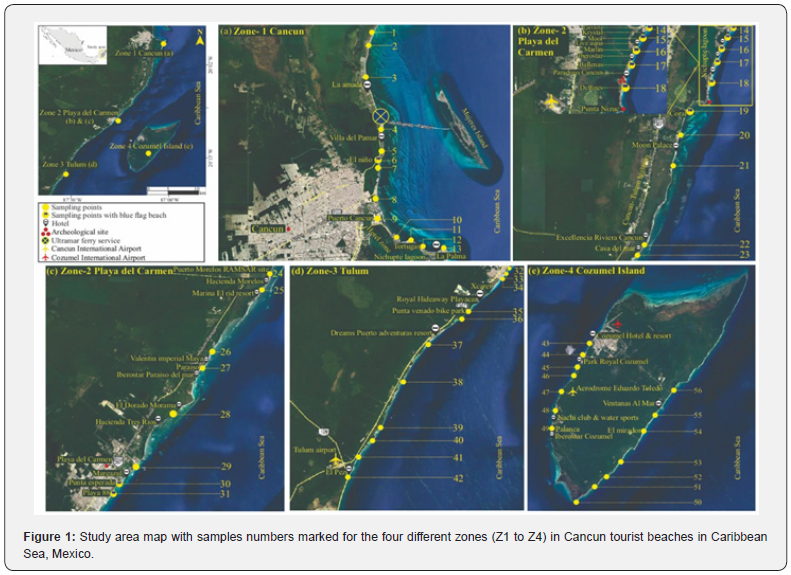
The study area is divided into four zones namely: Zone 1 (Z1 - Cancun: samples 1-13); Zone 2 (Z2 - Playa del Carmen: 14 – 31); Zone 3 (Z3 - Tulum: 32 – 42) and Zone 4 (Z4 - Cozumel Island: 43 – 56). The samples were collected in the intertidal region of selected tourist beaches which is occupied by luxurious resorts/ hotels certified as “Blue Flag” beaches and some public beaches (Figure 1). Field parameters pH, conductivity, dissolved oxygen was done directly using the multiparameter Hannah instrument (Model No. HI 9828-25) and the calibration was done using known calibration standards. Samples were collected for dissolved trace metals (1L) in pre-cleaned polyethylene bottles, which was subsequently acidified using high purity HNO3 to a pH of 2 and stored in refrigeration until analysis. Dissolved trace metals Fe, Mn, Cr, Cu, Co, Ni, Pb, Zn, Cd, Sr, V, As and major elements (Ca and Mg) were determined in IPN – CIIEMAD, Mexico using Atomic Absorption Spectrometer (Perkin Elmer Model Analyst 100) following the methods [22,23]. Estimation of as was done using cold vapor technique with hydride generation was utilized. Additionally, known sample solutions were added to all samples to know the recovery percentage of the dissolved metals in seawater. Certified reference material (CRM) (WatRTM Pollution trace metal Lote: P213-500) was used after every 10th sample during the analysis and lanthanum oxides were added to each sample to avoid spectral and non-spectral interferences. The overall precision in the present analysis of dissolved trace metals varied from 93.18 to 107.43% for the analyzed metals.
Calculating water quality index & Statistics
Determination of water quality in terms of metal concentration was done using the Heavy metal evaluation index (HEI) [24] using the formula:

Where Hc is the monitored value of the ith parameter and Hmac is the maximum allowable concentration of the ith parameter The HEI values are classified into three categories: HEI ˂ 400 (Less contamination); 400 – 800 (Medium contamination) and ˃ 800 (High contamination) respectively. Spearman correlation analysis (R-mode) was done for each zone separately using STATISTICA (version 12.0) to analyze the geochemical relationship of dissolved trace metals in the region.
Results and Discussion
Major elements and environmental variables
The results of pH, conductivity and dissolved oxygen showed a similar trend in both monitoring seasons, with a clear influence of the rainy season on conductivity in 2020 (Figure 2a-c). The concentrations and distribution of pH in the region during both years did not indicate any important change, and the lowest values observed in Playa del Carmen (Z2) and Tulum (Z3) are directly related to groundwater discharges through the region which was corroborated by the high association with the other environmental variables mainly during 2019, in addition to the zonal advection and the changes in the surface wind force [25,26]. The conductivity of both years showed a significant variation (2019: Z4 ˃ Z1 ˃ Z2 ˃ Z3; 2020: Z1 ˃ Z2 ˃ Z4 ˃ Z3) with average values of 54.57 and 40.2 mS cm-1 in 2019 and 2020 respectively. The relationship between the environmental variables pH and conductivity did not show significance between them except for the Playa del Carmen region in both years, and the abrupt changes in the conductivity values during both seasons together with the observed values, suggest the control of oxygen in water over the redox potential of seawater [27]. The three-fold increase in conductivity values in 2020 than 2019 infers that rainfall episodic events are all specific features of shallow coastline and freshwater discharge influencing this parameter [28,29].

Dissolved oxygen indicates a variation from 3.91 to 10.51 mg L-1 in 2019 (avg. 7.79) and 2.72 to 9.82 mg L-1 in 2020 (avg. 6.94). Zone wise calculated values indicates that Z2 ˃ Z3 ˃ Z1 ˃ Z4 respectively. The low distribution of DO is directly related to the organic matter degradation/ remineralization in the coastal region as well the terrestrial ground water which is recirculated in sea water [30]. Moreover, the low-oxygen ground water discharges due to the karst topography features present in the region will directly contribute to low oxygen level diluting the DO in coastal bottom waters [31]. The very low value (< 5 mg L-1) in Z2, Z3 is characterized by intermittent discharge of effluents/runoff and moreover heavy presence of the degrading Sargassum species in the coastal regions especially in low tidal areas [32,33].
The distribution of Ca and Mg were similar in both seasons (Figure 2d-e), and their concentrations in 2019 (averages Ca: 346 mg L-1, Mg: 761 mg L-1) and 2020 (average Ca: 400 mg L-1 and Mg: 771 mg L-1) indicate a geogenic origin associated with the dissolution of the carbonate mineral (calcite and magnesite), which is the predominant rural rock in this region and reaches the coast through of groundwater enriched by treated or untreated wastewater [34]. The slightly higher average of Ca observed in 2020 was associated with a higher entry of groundwater and surface water from the runoff during the rainy season and that enriched the coast despite the decrease in the contributions of tourist activity because of the pandemic. Additionally, the large amount of organic matter contributed by Sargassum in both seasons, facilitated the dissolution of these minerals on the coast [35-37].
Dissolved trace metal concentrations (Fe, Mn, Cr, Cu, Ni, Co, Pb, Zn, Cd, Sr, V, As)
The concentration pattern of dissolved trace metals in seawater in the present study is in the following descending order (based on zonal avg.): 2019 Zone 1: Sr ˃ Pb ˃ Ni ˃ Co ˃ Fe ˃ Zn ˃ Cu ˃ V ˃ Cd ˃ Mn ˃ Cr ˃ As; Zone 2: Sr ˃ Pb ˃ Ni ˃ Co ˃ Fe ˃ Zn ˃ Cu ˃ Cd ˃ V ˃ Mn ˃ Cr ˃ As; Zone 3: Pb ˃ Sr ˃ Ni ˃ Co ˃ Fe ˃ Zn ˃ Cu ˃ Cd ˃ Mn ˃ Cr ˃ V and Zone 4: Pb ˃ Ni ˃ Co ˃ Sr ˃ Fe ˃ Cu ˃ Zn ˃ Cd ˃ Mn ˃ Cr ˃ V. Likewise, during 2020 in Zone 1: Sr ˃ Pb ˃ As ˃ Cu ˃ Fe ˃ Ni ˃ Zn ˃ Cd ˃ V ˃ Mn ˃ Co ˃ Cr; Zone 2: Sr ˃ Pb ˃ As ˃ Cu ˃ Fe ˃ Ni ˃ Zn ˃ Co ˃ Cd ˃ V ˃ Mn ˃ Cr; Zone 3: Sr ˃ Pb ˃ Cu ˃ As ˃ Zn Fe ˃ Ni ˃ Mn ˃ Co ˃ Cd ˃ V ˃ Mn ˃ Cr; Zone 3: Sr ˃ Pb ˃ Cu ˃ As ˃ Zn ˃ Fe ˃ Ni ˃ Mn ˃ Co ˃ Cd ˃ V ˃ Cr and Zone 4: Sr ˃ Ni ˃ Pb ˃ Cu ˃ Zn ˃ As ˃ Fe ˃ Co ˃ V ˃ Cd ˃ Mn ˃ Cr respectively (Figures 3,4).
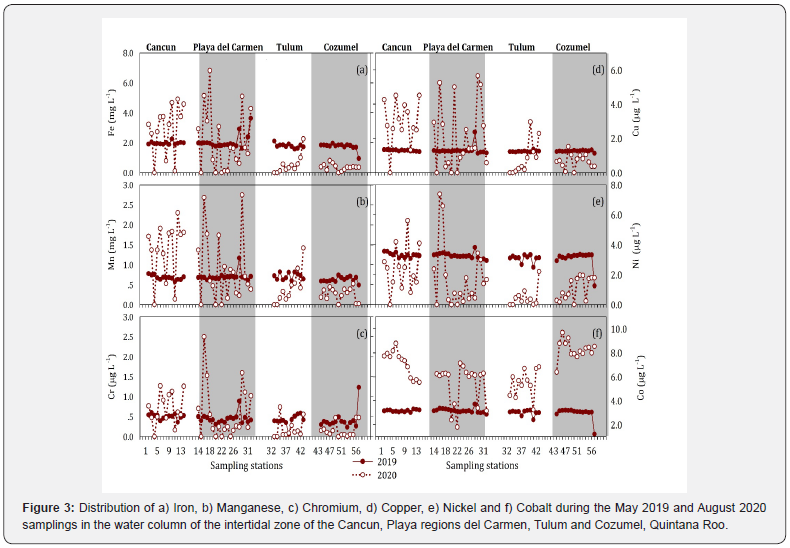
The concentration pattern of dissolved Sr in the region is high compared to other metals, indicating that they are strongly influenced by variations in composition based on the rocks of the continental bed [38]. The high concentrations of Sr in Z1 and Z2 in both periods (1.980 – 16.610 μg L-1) suggest dissolution of the young carbonate rocks, where complex geochemical interactions are generated from the evaporites. This is also supported by the variable mix of groundwater, where carbonates from the oldest Cretaceous or Cenozoic (Cancun and Puerto Morelos) dissolve to release Sr, and in the presence of fracture zone (near Tulum) and sinks closer to the coastal section where entry of submarine groundwater has already been reported [39,40].
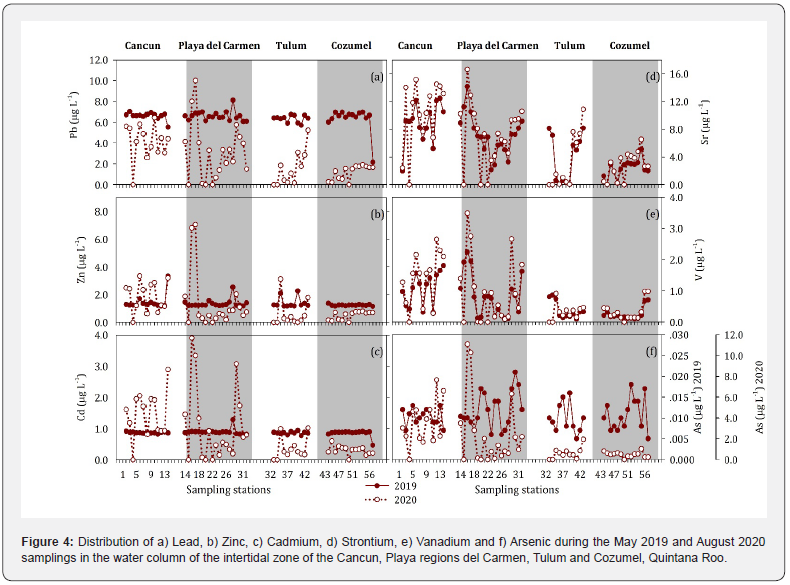
Fe and Mn concentrations during 2019 showed a similar distribution pattern and values in all zones (Fe ranges: 0.95- 3.64 mg L-1, Mn: 51-1174 mg L-1), while in 2020 it was observed greater variability with higher concentrations in Cancun and Playa del Carmen and lower in Tulum and Cozumel compared to the previous year (Figure 3a-b). The main source of Fe and Mn in this region is enrichment in groundwater inflow [41]. In 2019, the concentration of these elements had its origin mainly in the use of water from tourist and urban activities [42], which maintained very similar values throughout the region expect some sampling sites (S. No: 14,16,17,18,21,27). During 2020, although there was a reduction in tourism in the region (46%) with simultaneous decrease in anthropogenic sources of Fe and Mn, only in Tulum and Cozumel where this effect was clearly observed. This evident the fact that Cancun and Playa del Carmen have an important residing population (911,503 and 333,800 inhabitants respectively) [43] that endure the anthropogenic contribution of these metals. Additionally, during 2020, the intense rain (62 mm) by tropical storm “Marco” in August [44] which contributes high influx of terrigenous material and enriched groundwater towards the coastal zone.
The dissolved chromium concentrations in the present study indicate a different pattern compared to other metals analyzed (Figure 3c). The Cr distribution presents a higher average in Z1 (0.704 and 0.502) and Z2 (0.560 and 0.444) for 2020 and 2019 respectively. The concentrations obtained in both stations remained high for normal karstic environment, suggesting an enrichment due to anthropogenic activity [42]. In addition, the large amount of organic matter produced by the decomposition of Sargassum accumulated on the coast, especially the ligands result in higher concentration of Cr in solution [45,46]. In 2020, the obtained pattern for Cr indicates that the greater variability of Cr in that year was associated with rainfall in Z1 and Z2.
Ni showed higher concentrations in 2019, associated with its anthropogenic use as a component of paint on fishing boats in the tourist area [42] and others human activities. In 2020, confinement conditions in areas with a lower population result in lower concentrations, while high runoff impose a greater variability in Cancun and Playa del Carmen (Figure 3). Unlike the other dissolved metals, Co concentrations were higher during 2020, which was related to the redox sensitive nature of this element often released in the dissolved phase by decomposed organic material near the interface sediment-water [47,48]. In the area the accumulation of large amounts of Sargassum stimulated this mechanism, in addition, increasing the leaching of these materials because of runoff and the more intense waves during the “Marco” storm.
The highest values of Cu, Ni, Pb in 2019 in zones 1 and 2 are mainly due to the high movement of ferry services, construction and development activities in the region [42]. During 2019, higher concentrations of Pb detected in coastal waters which mainly due to high tourist activity, the use of fuels for local transport (boats, ferries, jet skis, automobiles). The pattern observed during 2020 was determined by runoff events along with decrease in tourist activity and urban activities mainly in Z1 and Z2 (Figure 4). The Zn values in the study region result from enrichment provoked using construction materials. The seasonal variation showed slightly low concentrations in 2020 (averages 2019: 1.36, 2020: 1.09 mg L-1; Figure 4a) caused by low anthropogenic activity related with confinement, and the higher variation in Cancun and Playa del Carmen was related to runoff events. The seasonal distribution of V for both stations show a similar pattern, where the presence of V is commonly noted in the karst groundwater environment [49].
The obtained results infer the slight variation in 2020 that the V source acquired from the runoff and its pathway from the local construction sites that they noticed with the use of steel alloys for construction [49]. The V in dissolved phase is generally scavenged by the oxidation of Fe- Mn markedly in the sediment-water through advective process [50]. Hence, it is evident for higher values in 2020 indicates resuspension during the storm events in the coastal region which increases in the dissolved V phase [51]. Sequential order of Zn in the present study suggest that it is behind Pb and Cu in both the years, indicating that it is due to the resuspension from the sediments high volume of suspended particulate matter in the dynamic region [52]. The concentrations of as obtained in the present work were found below the contamination levels, but the values during 2020 infers the influence of runoff which is enriched with higher concentration of as due to huge dumping and subsequent decomposition of Sargassum in the local land and near the beaches. Since, the decomposition of Sargassum mainly results with the discharge of leachates as their major byproduct which has major impact in the coastal environment [53].
In general, the results obtained showed differences in the intensity of anthropogenic activities between the sampling periods, which had a strong influence on the concentrations of dissolved metals during 2019 and 2020. The reduction of tourist activities by 47.5% during the COVID 19 pandemic had the greatest impact in areas with the smallest resident population (Tulum and Cozumel) [43]. On the other hand, in Cancun and Playa del Carmen, dissolved metals associated with anthropogenic activities showed greater variability and higher concentrations during 2020, which inferred the high influx of metals due to land-based rainfall and the intense mixing processes in the coast because of the tropical storm “Marco” registered during the month of August in the region [2,44].
Statistical analysis
The zonal wise correlation matrices for both years are presented separately in tables 1 and 2. The results of environmental variables (pH, DO and conductivity) with metals indicate that terrestrial, anthropogenic sources, the biogenic process, and hydrography play a significant role in the pattern of dissolved metals in the region between seasons. A clear difference was observed in the correlations of the physicochemical parameters and the concentration and variability of the metals in the area. In 2019, significant correlations were obtained with Cr, Ni, Co and Cd (Table 1), which suggests the entry of groundwater enriched with these metals that originate in urban, tourist and construction activities (Table 1) [42]. During 2020, a strong correlation was observed between trace metals and the main elements (Ca, Mg) (Table 2), associated with the effect of metal carryover by rainwater from urban areas during the rainy season in the coastal zone [42], that increased the concentrations of all metals, mainly those associated with anthropogenic activities in Cancun and Playa del Carmen, which due to being urban areas and having a high resident population (911,503 and 333,800 inhabitants respectively).
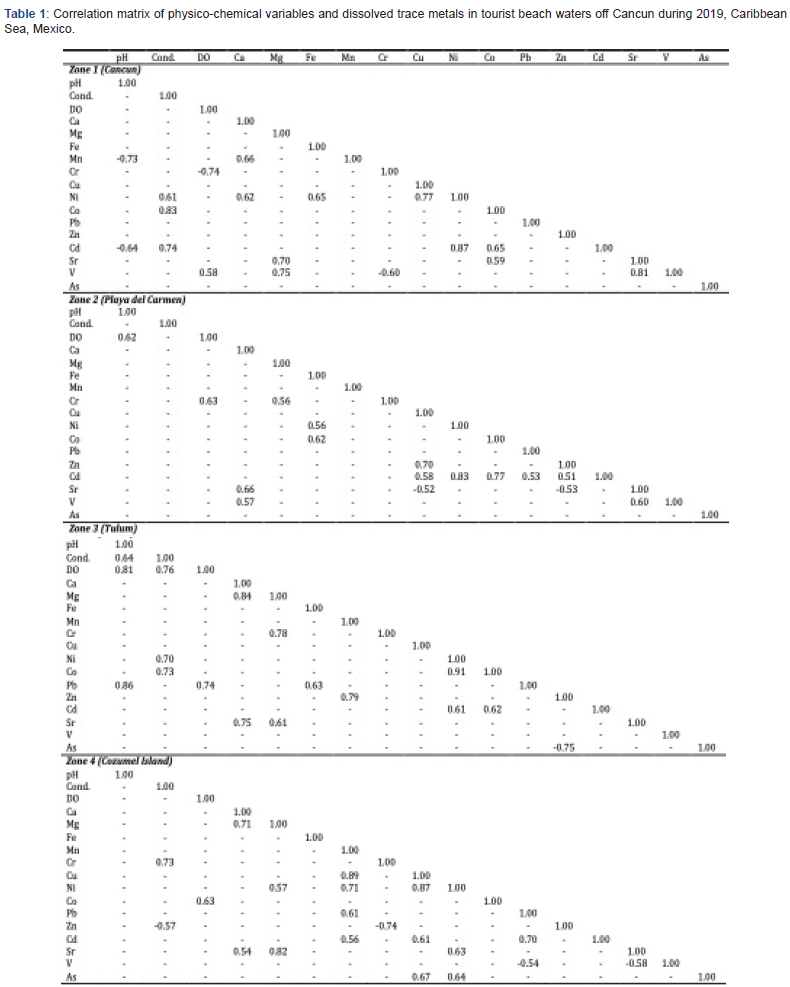
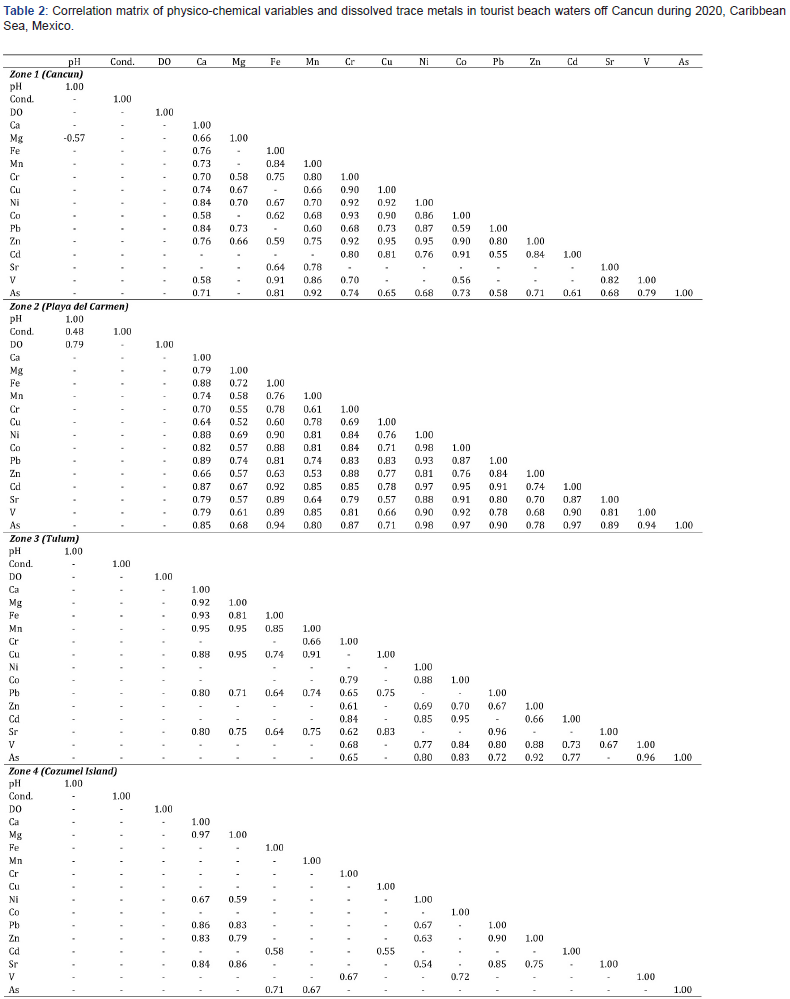
In the case of Tulum and Cozumel, the concentrations of metals in 2020 were lower, due to the reduction of the tourist influx, except for the case of metals from natural sources such as Sr and V which maintained similar patterns between samplings (Figure 4, Table 2). The results of the correlation analysis of Ca and Mg ions with some trace metals showed a strong association for 2019, especially with Sr and V due to their natural origin. The correlation of Mn with dissolved trace metals in the 2020 season especially infers that in sub oxic conditions the reduction of Mn occurs and acts as a scavenger for other metals with a high content of organic matter along the coast [54]. During this year, a strong correlation was obtained between all metals, mainly in Cancun and Playa del Carmen, which suggests that their concentrations were determined by common processes (Table 2), such as high urban activity. Dissolved Vanadium is almost last in the sequential order which correlates with high Fe values where high organic materials affect the flux of V leading to removal from seawater under high pH values [55].
Heavy metal evaluation index (HEI)
Calculated HEI values for all the four zones were done for 2019 and 2020 separately. All the trace metals (except Ni & Cd) were lower than the ˂400 indicating that the region is not contaminated with reference to beach water. However, Ni (1598, 735) and Cd (4355, 4050) were higher in both years 2019 & 2020 respectively. Higher values of Cd in both the seasons indicate strong active remineralization due to regular presence of high organic matter from in the study area dominant with coral sandy nature [55,56]. Likewise, Ni is also high in the present study enriched due to the various sub-oxic or anoxic regions in the coastal beaches, where mobilization of Ni takes place [57]. Moreover, higher dissolved Ni is often released into higher saline regions in the coast and minimum desorption takes place at freshwater seawater interface [58,59]. Overall, various coastal management practices are implemented by the local government, nevertheless natural geochemical process is disturbed due to excessive presence of organic materials which aids in enriching this metal well above the permissible limits.
Comparative studies
Comparison values of dissolved trace metals with other tourist beaches and coastal regions around the world indicates a twofold increase of Ni, tenfold increase of Pb and as (Table 3) [3,60-71]. Likewise, comparing the permissible limits with reference to EPA, and CONAGUA there is a two-to-ten-fold increase in the coastal region for most of the metals (except Sr, V) indicating that the strong developmental activities all along the coast in the coastal cities and tourism related pleasure trips have exerted the pressure on the coastal waters. Compared to other coastal beaches Cr, Ni, Pb, Cd and as indicates enrichment of two to five-fold which is mainly due to tourist, various developmental and recreational activities practiced in the study zone.

All values in mg L-1 ; AAS: Atomic Absorption Spectrometry; FAAS: Flame Atomic Absorption Spectrometry; ICPMS: Inductively coupled plasma mass spectrometry; *: Stripping voltammetry; **: Spectrophotometry
Conclusion
This study presents the results generated during two different years (2019 and 2020) suggest that the measured physicochemical variables have no direct relationship with the distribution of dissolved trace metals. The higher concentrations of dissolved trace metals in 2019 are mainly due to intense tourism development activity in the coastal stretch, while in 2020, the greater variability in concentrations related to the drop-in tourism activity due to the social confinement, and the eventual effect of terrestrial runoff during the rainy season. Although the anthropogenic pressure on the coastal ecosystem decreased during the pandemic period, it is clear that the region has a long way to go that requires a continuous effort to generate scientific knowledge that provides adequate information to identify the mixed pressures of anthropogenic and natural factors and with this, generate an adequate program for the management of natural resources of the Mexican Caribbean coast.
To Know More About Oceanography & Fisheries Open Access Journal Please click on:
For more Open Access Journals in Juniper Publishers please click on:

Comments
Post a Comment